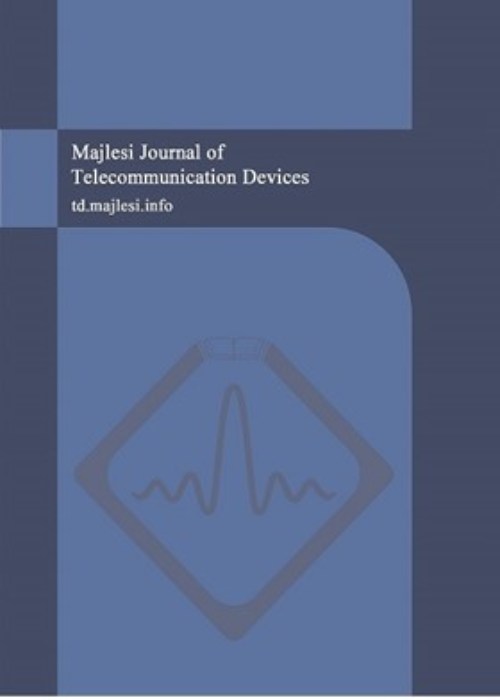فهرست مطالب
Majlesi Journal of Telecommunication Devices
Volume:8 Issue: 1, Mar 2019
- تاریخ انتشار: 1398/02/28
- تعداد عناوین: 5
-
Pages 1-5We design and simulate an efficient wavelength division demultiplexer (WDDM) based on photonic crystal without using either specific materials or complexities in the fabrication process. The photonic crystal consists of a square lattice of Chalcogenide glass with embedded in air in two dimensions. The structure involves three cavities around the boundary of the waveguide with specified distance from each other for wavelength selection. For obtaining resonant frequencies of the cavities, two dimensional Finite-Difference-Time-Domain (FDTD) simulation is used. Through simulations, characteristic resonant wavelengths of the cavities are obtained in terms of the size of the coupling rods and the inner rod of the cavity. To show the design flexibility of the proposed structure, a WDDM is designed to divide a common input containing wavelengths and into three distinct ports with a high efficiency..Keywords: Photonic Crystal, Optical Wavelength Division Demultiplexer, fabrication process
-
Pages 7-12P. Elias proposed convolutional coding at 1955. Convolutional encoders have very simple structure but their decoders are very complex and power consumer. Power consumption and error correction of Convolutional Codes, will be enhanced by increase in their constrain length, therefore there is always a trade-off between Power consumption and error correction. In Convolutional Codes, the code specifications remain constant in each frame. If the specifications are changed during each frame in a code, a new code with new performance and specifications is created. This paper, aims to evaluate this issue for the first time and compare its performance with Convolutional Codes. This new code is named “Decimal Convolutional”. If in a decimal convolutional code, constrain length is changed during each frame, the generated code will be a convolutional code with “decimal constrain length”. In this paper, a convolutional code with decimal constrain length is introduced, encoder and Viterbi decoder structure is explained for it and its specification is compared with convolutional code. Using this code, an optimized constrain length can be obtained and relative power consumption of decoder can be also reduced. The proposed design blocks are described by VHDL and they are implemented on Xilinx Spartan3, Xc3s400 FPGA chip.Keywords: Decimal Convolutional Code, Viterbi Decoder, FPGA, Low Power
-
Pages 13-19Today, biometric recognition (based on biological signs) is a common and reliable method for recognizing and identity confirmation based on their behavioral and physiological characteristics. Physiological characteristics are consistent with the physical characteristics of individuals such as fingerprints, iris pattern, facial features, and the like. This type of property often does not change without external exertion. Behavioral characteristics such as signature, spoken pattern and iris are also a scale for identification and identity confirmation. In this study, using the wavelet method, the efficiency of human identification was increased by 75%.Keywords: iris identification, wavelet
-
Pages 21-25Intrusion Detection System is one of the most important security features of modern computer networks that can detect network penetration through a series of functions. This system is independently used (e.g. Snort) or with various security equipment (such as Antivirus, UTM, etc.) on the network and detects an attack based on two techniques of abnormal detection and signature-based detection. Currently, most of the researches in the field of intrusion detection systems have been done based on abnormal behavior using a variety of methods including statistical techniques, Artificial Intelligence (AI), data mining, and machine learning. In this study, we can achieve an effective accuracy using a candidate class of the KDD dataset and deep learning techniques.Keywords: Intrusion Detection System, Network Security, Deep Learning
-
Pages 27-34The production of additional cells often forms a mass of tissue that is referred to as a tumor. Tumors can disrupt the proper functioning of the brain and even lead to the patients' death. One of the non-invasive diagnostic methods for this disease is Magnetic Resonance Imaging (MRI). The development of an automated or semi-automatic diagnostic system is required by the computer in medical treatments. Several algorithms have been used to detect a tumor, each with its own advantages and disadvantages. In the present study, an automatic method has been developed by the combination of new methods in order to find the exact area of the tumor in the MRI image. This algorithm is based on super pixel and RVM classification. The algorithm used in the super pixel method is the SLIC algorithm, which calculates for each super pixel 13 statistical characteristics and severity. Finally, an educational method introduced from the RVM classification algorithm that can detect the tumor portion from non-tumor in each brain MRI image. BRATS2012 dataset and FLAIR weights have been utilized in this study The results are compared with the results of the BRATS2012 data and The overlap coefficients of Dice, BF score, and Jaccard were 0.898, 0.697 and 0.754, respectively.Keywords: Magnetic resonance imaging, Super pixel classification, Relevance vector machines classification


